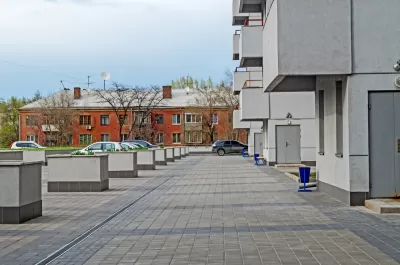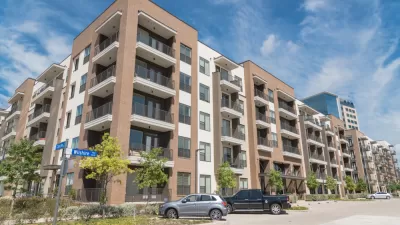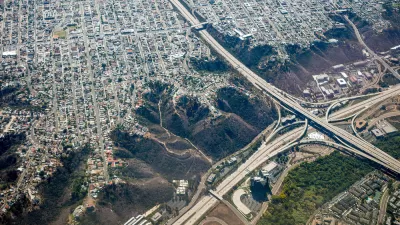Leading researchers debate whether more compact urban development reduces automobile travel in the Journal of the American Planning Association. The issues are complex and important.

Compact development is often recommended as a way to get people to drive less and create more sustainable communities. However, different studies over the years have yielded different outcomes, leading to a muddled understanding about the true impact of compact development. After using meta-aggression analysis, Mark R. Stevens of the University of British Columbia, concludes that planners should not rely on compact development as their only strategy for reducing driving, as it doesn’t have much of an impact.
In the article, "Does Compact Development Make People Drive Less?" in the Journal of the American Planning Association (Vol. 83, No. 1), Stevens looks at nearly 20 years of research and the different outcomes from measuring changes to one of the five features of compact development referred to as the “D-variables” — density, diversity, design, destination accessibility, and distance to transit. He writes that his analysis is the first step in reducing the confusion generated from the multitude of studies and helps improve the understanding of compact development’s influence on driving.
Stevens concludes that planners “should probably not assume that compact development will be very effective” in achieving the goal of reducing driving. “At minimum, planners and municipal decision makers should not rely on compact development as their only strategy for reducing VMT (vehicle miles traveled) unless their goals for reduced driving are very modest and can be clearly achieved at a low cost.”
Stevens’s research has ignited a passionate debate over compact development’s true impacts. Reid Ewing and Robert Cervero, professors at the University of Utah and the University of California, Berkeley, co-authored one of the most cited JAPA articles about compact development. They comment that their greatest concern is that Stevens has overreached in his conclusions.
Susan Handy, professor at the University of California, Davis, comments that compact development cannot reduce driving very much on its own, but we cannot reduce driving very much without it. She writes that communities need to make it possible to drive less, help people understand how to drive less, and make people want to drive less.
Michael Manville, assistant professor at UCLA Luskin School of Public Affairs, adds his voice to the mix. He comments that planners should focus instead on the free land provided to cars instead of studying the 5Ds. “Travel’s influence on the built environment is a function of the built environment designed for travel. We should stop pretending otherwise.”
Gerrit-Jan Knaap and Uri Avin, FAICP, professors at the University of Maryland, College Park, and PhD candidate Li Fang, comment that Stevens’s revelation about compact development is not new. “There is nothing wrong with his conclusion that if planners want to reduce VMT they should not expect to have much influence through changing urban form. But in many respects this conclusion is nearly obsolete.”
Arthur Nelson, FAICP, professor at University of Arizona and Presidential Professor Emeritus at the University of Utah, comments that “it is possible that planners do not know how to apply insights of statistical analysis such as those that Stevens references and synthesizes.” He concludes that it is time for the insights of researchers referenced by Stevens, and Stevens himself, to be made accessible to planners.
FULL STORY: Study Sparks Debate Over Relationship Between Compact Development and Driving

Pennsylvania Mall Conversion Bill Passes House
If passed, the bill would promote the adaptive reuse of defunct commercial buildings.

Planning for Accessibility: Proximity is More Important than Mobility
Accessibility-based planning minimizes the distance that people must travel to reach desired services and activities. Measured this way, increased density can provide more total benefits than increased speeds.

World's Largest Wildlife Overpass In the Works in Los Angeles County
Caltrans will soon close half of the 101 Freeway in order to continue construction of the Wallis Annenberg Wildlife Crossing near Agoura Hills in Los Angeles County.

Eviction Looms for Low-Income Tenants as Rent Debt Rises
Nonprofit housing operators across the country face almost $10 billion in rent debt.

Brightline West Breaks Ground
The high-speed rail line will link Las Vegas and the Los Angeles area.

Colorado Bans No-Fault Evictions
In most cases, landlords must provide a just cause for evicting tenants.
City of Costa Mesa
Licking County
Barrett Planning Group LLC
HUD's Office of Policy Development and Research
Mpact Transit + Community
HUD's Office of Policy Development and Research
Tufts University, Department of Urban and Environmental Policy & Planning
City of Universal City TX
ULI Northwest Arkansas
Urban Design for Planners 1: Software Tools
This six-course series explores essential urban design concepts using open source software and equips planners with the tools they need to participate fully in the urban design process.
Planning for Universal Design
Learn the tools for implementing Universal Design in planning regulations.


























